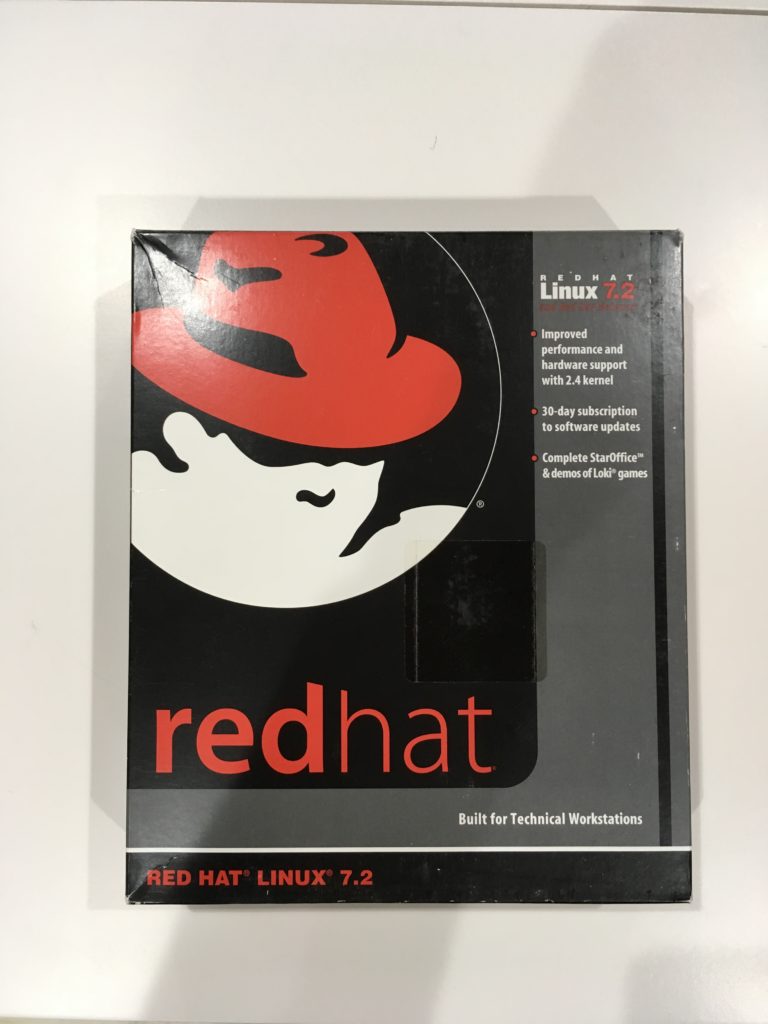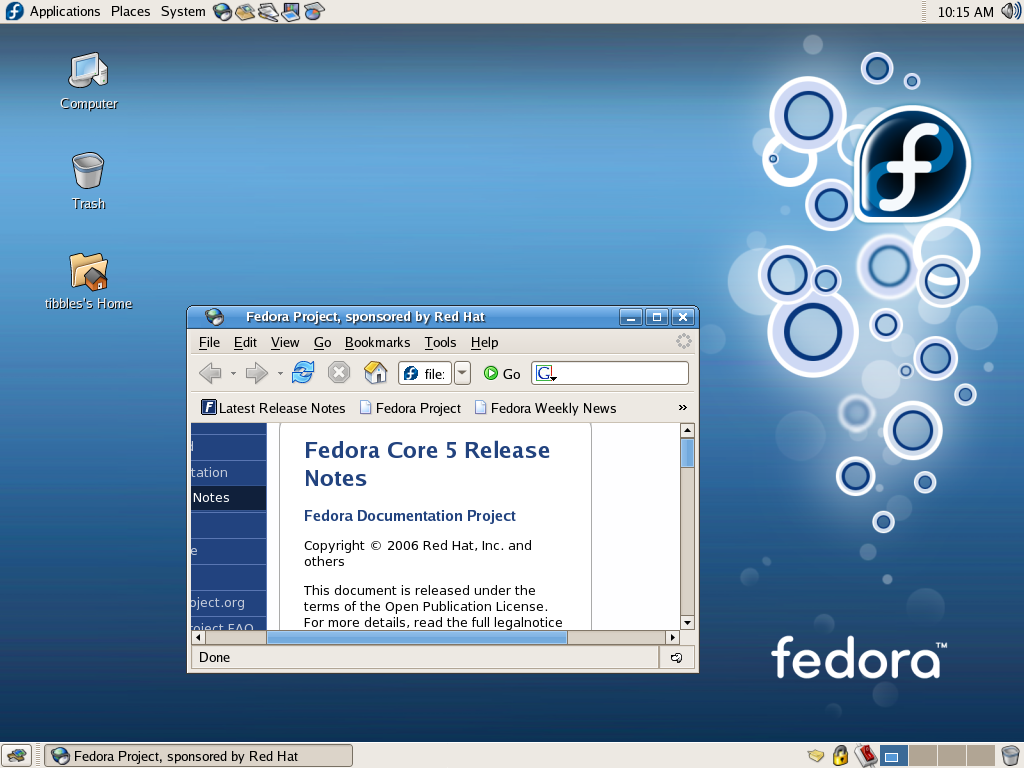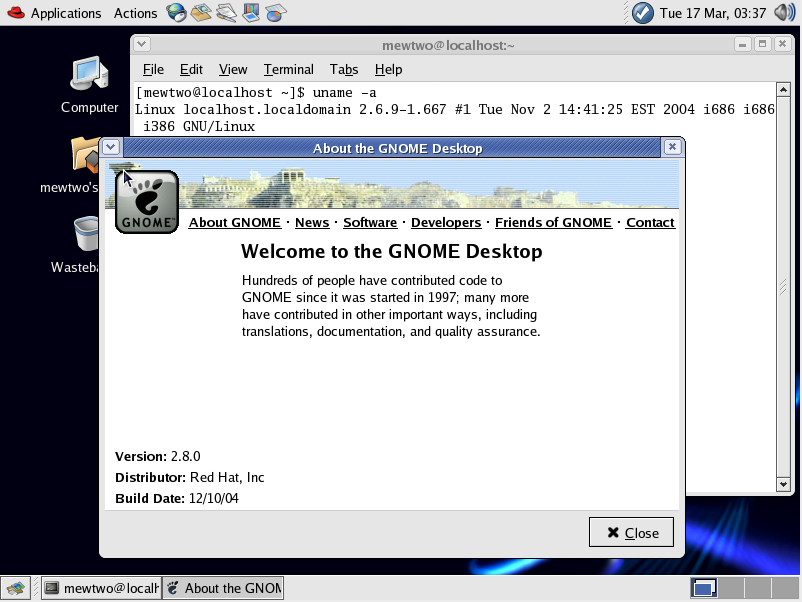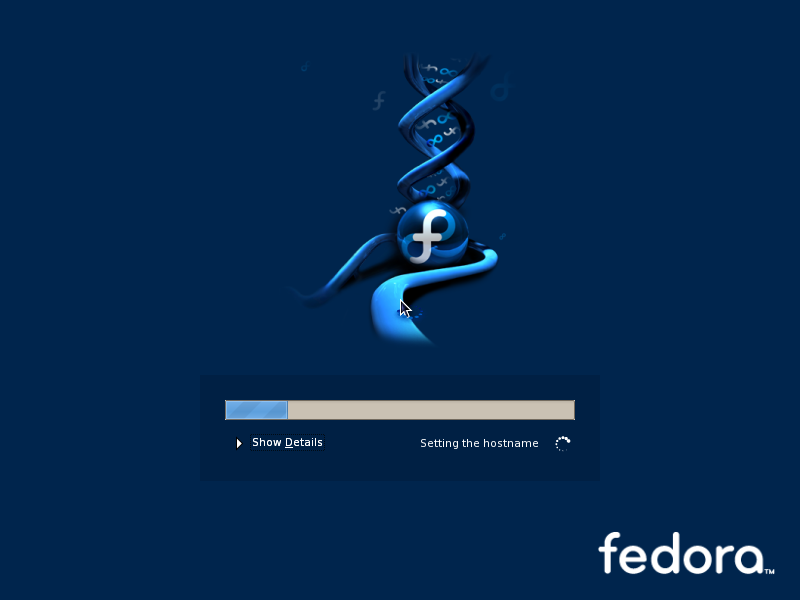Editor’s comment: The format of this article is different from the usual article that Fedora Magazine has published: a Fedora origins story told from the point of view of a Fedora user. The author has chosen to tell a story, since to simply present the bare facts is akin to just reading the wiki page about it.
Hello World!
Hello, I am… no, I’m not going to give my real name. Let’s say I’m female, probably shorter and older than you. I used to go by the nick of Isadora, more on that later.

Now some context. Back in the late ’90s, internet became popular and PCs started to be a thing. However, most people didn’t have either because it was very expensive and often you could do better with the traditional methods. Yes, computers were very basic back then. I used to play with these pocket games that were fascinating at the time, but totally lame now. Monochrome screens with pixelated flat animations. Not going to dive there, just giving an idea how it was.
In the mid-90s a company named Red Hat emerged and slowly started to make a profit of its own by selling its own business-oriented distribution and software utilities. The name comes from one of its founders, Marc Ewing, who used to wear a red lacrosse in university so other students could spot him easily and ask him questions.
Of course, as it was a business-oriented distribution, and I was busy with multiple other things, I didn’t pay much attention to it. It lacked the software I needed and since I wasn’t a customer, I was nobody to ask for additions. However, it was Linux and as such Open Source. People started to package stuff for RHL and put it in repositories. I was invited to join the community project, Fedora.us. I promptly declined, misunderstanding the name. It was the second time I got invited that I asked ‘what is with the “US” there (in the name)?` Another user explained it was ‘us’ as in ‘we’ not as in the ‘United States.’ They explained a bit about how the community worked and I decided to give it a go.
Then my studies got in the way, and I had to shelve it.

Press Return
By the time I came back to Fedora.us it had changed its name to Fedora Project and was actively being worked on from within Red Hat. Now, I wasn’t there so my direct knowledge of how this happened is a bit foggy. Some say that Fedora existed separately and Red Hat added/invited them, some say that Fedora was completely RH’s idea, some say they existed independently and at some point met or joined. Choose the version you like, I’ll put some links down there so you can know more details and decide for yourself. As far as I’m concerned, they worked together.
Well, as usual someone dropped some CDs with ISOs for me. If I had an euro for every ISO I’ve been offered, or had tossed at my desk, for me to try it, I would be rich. As a matter of fact, I’m not rich but I do have a big rack full of old distros.
Anyways…
Now it’s the early 2000s and things have changed dramatically. Computers’ prices have dropped and internet speed is increasing, plus a set of new technologies make it cheaper and more reliable. Computers now can do so much more than just a decade ago, and they’re smaller too. Screens are bigger, with better colors and resolution. Laptops are starting to become popular though still expensive and less powerful than desktop PCs.
During this time, I tried both Fedora and Red Hat. Now, as has been said before, Red Hat focuses on businesses and companies. Their main concern is having exactly the software their customers need, with the features their customers need, delivered as rock solid stability and a reliable update & support cycle. A lot of customization, variety of options and many cool new features are not their main core. More software means more testing and development work and bigger chances of things failing. Yet the technology industry is constantly changing and innovating. Sticking too much to older versions or proven formulas can be fatal for a company.
So what to do? Well, they solved it with Fedora. Fedora Project would be the innovative, looking ahead test bed, and Red Hat Enterprise Linux was the more conservative, rock solid operating system for businesses. Yes, they changed the name from Red Hat Linux to Red Hat Enterprise Linux. Sounds better, doesn’t it?
Unsurprisingly, Fedora had a fame of being difficult, unstable and for “hackers only”. Whenever I said I was using Fedora, they would give me odd looks or say something like “I want something stable” or “I’m not into that” (meaning they didn’t fancy programming/hacking activities). Countless individuals suggested I might want to use one of the other, beginner-friendly distributions, without themselves even giving Fedora a try! Many would disregard Linux as a whole as an amateur thing, only valid for playing but not good for serious work and companies. To each their own, I suppose.

Yes, but why?
Those early versions were called Fedora Core and had a very uncertain release pattern. The six months cycle came much later. Fedora Core got its name because there were two repositories, Core and Extras. Core had the essentials, so to speak, and was maintained by Red Hat. Extras was, well, everything else. Any software that most users would want or need was included there, and it was maintained by a wide range of contributors.
From the beginning, one of the most powerful reasons for me to use it was the community and its core values. The Four Foundations of Fedora, Freedom, Features, First & Friends were lived and breathed and not just a catchy line on a website or a leaflet. Fedora Project strove (and still does) to deliver the newest features first, caring for freedom (of choice and software) and keeping a good open community, making friends as we contribute to the project.
I also liked the fact that Fedora, as its purpose was testing for Red Hat, delivered a lot of new software and technologies; it was like opening the window to see the future today.
The downside was its unreliable upgrade cycle. You could get a new version in a few months or next year… nobody knew, there was no agreed schedule.

What was in the box
Fedora Core kept this name up to the sixth version. From the start, it was meant to be a distribution you could use right after installing it, so it came with Gnome 2, KDE 3, OpenOffice and some browser I forgot, possibly Firefox.
I remember it being the first to introduce SELinux and SystemD by default, and to replace LILO with GRUB. I also remember the hardware requirements were something at the time, although they now sound laughable: Pentium II 400MHz, 256MB RAM (yes, you read it right) and 2GB of space in disk. It even had an option for terminal only! This would require only 64MB RAM and Pentium II 200MHz. Amazing, isn’t it?
It had codenames. Not publicly, but it had, and they were quite peculiar. Fedora Core 1 was code named «Yarrow» which is a medium size plant with yellow or white crown-like flowers. Core 2 was Tettnang which is a small town in Baden-Württemberg, Germany. Not sure about Core 3, I think it was Heidelberg, but maybe I’m mixing with later releases. Core 4 was Stentz, if I recall correctly (no idea what it means), Core 5 was a colour, I think Bordeaux, and Core 6 was Zod that I think it was a comic character but I could be wrong. If there was a method in their madness I have no idea. I thought the names amusing but didn’t give a second thought to it as they didn’t affect anything, not even the design of each release.

So what now?
Well, of course, Fedora Project has evolved from where we have stopped. But that’s for later articles or this one will be too long. For now, I leave you with an extract of an interview with Matthew Miller, current Project Leader and some links in case you want to know more.
Extracts to interview with Matthew Miller, Project Leader.
Matthew Miller tells about the beginnings in Eduard Lucena’s podcast (transcription here): “Fedora started about 15 years ago, really. It actually started as a thing called Fedora.us.” Back in those days, there was Red Hat Linux.” “Meanwhile, there was this thing called Fedora.us which was basically a project to make additional software available to users of Red Hat Linux. Find things that weren’t part of Red Hat Linux, and package them up, and make them available to everybody. That was started as a community project.”
“Red Hat (then) merged with this Fedora.us project to form Fedora Project that produces an upstream operating system that Red Hat Enterprise Linux is derived from but then moves on a slower pace.”
“We were then two parts, Fedora Core, which was basically inherited from the old Red Hat Linux and only Red Hat employees could do anything with and then Fedora Extras, where community could come together to add things on top of that Fedora Core. It took a little while to get off the ground but it was fairly successful”
“Around the time of Fedora Core 6, those were actually merged together into one big Fedora where all of the packages were all part of the same thing. There was no more distinction of Core and Extras, and everything was all together and, more importantly, all the community was all together.
They invited the community to take ownership of the whole thing and for Red Hat to become part of the community rather than separate. That was a huge success.”
Links of interest
Fedora, a visual history
https://www.phoronix.com/scan.php?page=article&item=678&num=1
Red Hat Videos – Fedora’s anniversary
https://youtu.be/DOFXBGh6DZ0
Red Hat Videos – Default to open
https://youtu.be/vhYMRtqvMg8
Fedora’s Mission & Foundations
https://docs.fedoraproject.org/en-US/project/
A short history of Fedora
https://youtu.be/NlNlcLD2zRM






Chris
WOW Fedora Core 2 with Gnome 2 was exactly where I discovered the wonders of Linux. Seeing these screenshots brings back the excitement I originally had when I discovered it. Thanks for this.
Sylvia Sánchez
You’re welcome! I’m glad you like the article. There will be more with later periods of Fedora’s history.
Gayland
Not really a comment but pardon my ignorance what exactly is a ” red lacrosse”. My only referent has me wondering how one wears a sport.
Thanks for this trip down memory lane. Fedora has been my safe place for years now, though many around me promote other distributions. It’s always provided me what I’ve needed and has saved me from being trapped in Corporate America’s two biggest technology traps. Guess there is a comment in here after all. Yeah, the email address, is ironic but what can you do.
Sylvia Sánchez
A lacrosse is a type of hat that looks roughly similar to fedoras (another type of hats).
I’m happy to know Fedora is your safe place. Mine too, it cured my distrohopping forever.
roypen
Great story. A little nostalgic, interesting and concrete. Very nice to read. I can’t wait for part 2.
Is there any chance to run Fedora Core on modern machine or VM?
Sylvia Sánchez
That is a good question. In theory, you could setup a VM with the same specs (Pentium II, 256~512 MB RAM) and install Fedora Core on it. I never tried myself, so I don’t know if in practice it works. I remember trying it in an extremely old computer that was in its last leg. It worked.
Roypen
Good news. I installed Fedora Code 1 on VM using libvirt. It works right out of the box. Now I’m playing around with it and it brings back nice memories of past times. I remember when I first saw Fedora and Red Hat I was amazed. I knew that I was looking at something different, magical, unknown. It was like exploring unknown land full of advanced artefacts of alien civilization. I know this may sound crazy, but I can’t describe this feeling in any other way. Fedora Core release was nearly 20 years ago but I feel like 2003 was only a few of months ago. Well, I am old 😉
Sylvia, thank you for this article.
Lukas
Sylvia Sánchez
Hello Lukas,
Thanks for your comment! I’m the other way around, I feel like 2003 is ages ago, and writing about technologies from 20 years ago is like writing about Ancient Rome. I don’t feel it close but very far because so many things happened and so much changed.
Just my POV, I’m old too.
🙂
cmdrlinux
Yes, there are many videos of people installing and running Fedora Core [X] as virtual machines on Youtube. If you search for “fedora core 1” or “fedora core 2” you can find them.
Jalal
I have started using Fedora, since the release number 3, a very long back.
And since then I fall in love with it.
bleav
‘Stenz’ means ‘playboy’ in the Bavarian dialect of German. 🙂
Sylvia Sánchez
Oh! Thank you so much! I’ve been wondering this for a long time and I searched online but to no avail. Interesting how many German words were present in the early versions.
Thanks!
wips
Core 1/2/3 name was related to beer.
Core 4/5 name was related to wine.
https://fedoraproject.org/wiki/History_of_Fedora_release_names
Steven
Looooooooong time Redhat user since late 90s, version 5.2 I guess, when it still was not fully intendet for the enterprise. Then thru 7, 8, 9. Then Enterprise 2.1, 3 and till today on RH 7. And at the same time, Fedora since its beginning, til right now. Favorite and best distro ever. Thank you Redhat and Fedora teams for your commitment.
Sylvia Sánchez
Teams’ commitment is definitely worth praising. I never really used Red Hat, but Fedora has been my distro ever since I tried it first time.
Nuno
Great article.
It brings too many good memories!
I’ve been using Red Hat since I managed to buy my own first PC (laptop).
The photo in the article remembered me having a great deal of trouble installing Red Hat 7… And then came Fedora Core… And the fedora.
Although I tried a lot of different distros (like everybody geek else at the time – distro war!), I kept using Fedora (a freak among the geeks)… and wow… 32 now!
Thank you again for your article and the good memories!
Sylvia Sánchez
Thank you so much! I’m glad you enjoyed the read.
digital
My home PC was Red Hat 5.1, later upgraded to 5.2->6->6.1…->9->Fedora Core 1->… and now it’s Fedora 32. Never reinstalled, only upgraded (once even from 32 to 64 bits). Of course, hardware changed, but OS was never reinstalled from scratch.
bohrasd
I love fedora and you people have been great!
Eduard Lucena
I’m pretty sure that the codename of the versions, that still exist, have to do with the art that will be designed in each release: https://fedoraproject.org/wiki/Design/Release_Artwork_Process
Eduard Lucena
Well, actually the released versions aren’t codenamed anymore, but there is an “Inspiration” that is decided by the design team to select a theme to work on the art of the release. Interesting to know
Sylvia Sánchez
Yes, the part about code names will come in later articles, and in due time I’ll explain why Isadora (mentioned in the beginning of the article) and why names were eventually dropped.
Sylvia Sánchez
If you look at the list of historical releases it only goes until Fedora 8. As far as I know, it didn’t have much influence in the system or design. But someone can correct me if they worked in Fedora Core back then.
Giovanni Fabbro
Man, those isometric icons sure look swank.
Sylvia Sánchez
I love them too. Probably more than the present trend.
Leslie Satenstein
I am Grandfather Leslie. I started with RedHat before there was Fedora. I switched to Fedora just after it left being Fedora.us. I have been a Fedora user ever since. Fedora works for me.
Like all other curious Linuxers, I do explore other distros. But, for whatever reason, I decline to switch. My nearly 16 years of using Fedora have been a great plus in my technical life. I will shoot you if you try to take Fedora away from me.
Sylvia Sánchez
Hello Grandfather Leslie!
So good to see you here. Thanks for your comment, I appreciate it. And yes, I do that as well, try other distros but always come back to Fedora.
Iztok
I have started with Fedora Core 1 and this was a love at first sight …
That lasts till today …
Steven Bakker
Thanks. Nice trip down memory lane for me as well. I started using RHL in 1998, IIRC, dual booting with Windows. Did that for years over the course of several laptops, until I noticed I hadn’t booted Windows in two years. Since then, I always wipe the whole disk of a new laptop before installing Fedora.
Regarding the codenaming, that was inherited from RHL and used a bizarre scheme. A new release code name had to have a relation to the previous name, but the relationship could not be the same as the one before that.
Example:
4.95 = Thunderbird => Ford model
4.96 = Mustang => Ford model, WW2 fighter
5.0 = Hurricane => WW2 fighter, cocktail
5.1 = Manhattan => cocktail, project
5.2 = Apollo => project, Battlestar Galactica character
5.9 = Starbuck => Battlestar Galactica character
Not sure if that continues into RHEL nowadays, but for Fedora it was kept until Fedora 21, at which point they just went for a literal transcription of the version number (“Twenty One”); this continues to this day (“Thirty One”).
See also https://fedoraproject.org/wiki/History_of_Fedora_release_names
Sylvia Sánchez
Oh, thank you so much. I remember how names where chosen in later versions, but I didn’t know this also applied to Fedora Core. Thanks for the information.
And nice to see an old RHEL & Fedora user :3
Steven Bakker
Emphasis on “old”. 😀
Joao Rodrigues
Just to put things into perspective, I remember in ’94 my parents bought me a (very expensive) desktop pc. It cost about 2000 € (in 90’s money)
It had an Intel 486DX4 single-core CPU running at 0.1 GHz and 0.008 GB of RAM. It also had a 0.54 GB HDD, a 4 speed CD-ROM drive and a Sound Blaster 16 sound card.
Sylvia Sánchez
And we felt that it was amazing and it was hardly possible to improve. And look at us now. Computers are a quarter that value and so much more powerful.
Same with internet. I remember attending courses in the 90s where they explained about the dazzling speed of 50kbs, and we were “Woooaaaah”.
Everything changed so much and so fast in such a short time.
Roypen
I had 486DX4 120 MHz in ’97 . In 1994 I was pushing my turbo button on 386 SX with 16 or maybe even 25 MHz. 🙂
Brian
I started using Red Hat before it became Fedora Core, after my fifth virus infestation on MSt windows wiped out my anti-virus software. I started with a trip to the book store and a purchase of Linux Mandrake as an almost complete computer illiterate, and installed it on my Compaq Presario, which wasn’t really supposed to work. It actually ran better with Linux. I then switched to Red Hat. The only thing I miss about MSt, is shelling out big bucks for apps that don’t usually work any better than Linux equivalents, and the commercially driven games that refuse to create versions for Linux……oh yeah, and Chessmaster, but that’s probably just nostalgia. I can play several versions of Chess on Linux… and I’m not going to Wine about it 😉
Aside from that, I’ve never looked back — and will never go back.
Brian
Beefy Miracle was a big jump forward for Fedora, and you might be interested in this…… https://opensource.com/life/12/5/whats-beefy-miracle-anyway-story-fedora-17-release-name
Andrzej Rośkowicz
I started a while later, with Fedora 17, it had goofy code-name “beefy miracle”.
The package manager was called “yum” so I thought there is some food theme going on in this distribution ^^
Then there was Spherical Cow, Schrodinger Cat and Heisenbug, which made no sense at all.
tony
oh I miss them names lol. beefy miracle, spherical cow, Schrodinger cat.
I started with Debian (slink i think it was) in 99. didn’t go full time linux till about 2000. did the Ubuntu thing in 2004’sih didn’t come to the fedora side until about 2010. since using Fedora its been my main go to now for desktop. (KDE of course) I have tried other distros since and while I think a few of these other distros maybe performed a certain thing better in one way or another they would lack balance and id be left missing something. Fedora seems to just have a balance of everything working.
Ryan
I first discovered linux in Oct 1999 where a little distro called “Morphix” was on the CD on the front of that edition of APC mag (Australian PC magazine). I ran the live cd on my computer for a little bit and enjoyed playing frozen bubble and some of the other included games but that was about the extent of my first foray into Linux. I didn’t really revisit it until 2002 when I was introduced to RedHat Linux (6 maybe) at a tech college I went to. I was asked to do a few basic things (apache maybe) and then we were told we could have a look at it and do what we wanted. I ended up running up a DHCP server and was amazed at how powerful this Linux thing was (I ended up bringing the whole college network to it’s knees across a couple of campuses because they hadn’t properly isolated the student network). After that I continued to play around with RedHat linux in my home lab going through 7 and 8 and then Fedora Core 1. I continued through every subsequent version and am still running Fedora although now instead of being just a lab, I run it as my primary OS at home and at work (luckily my employer is flexible about what we run as long as we can do our work). Although I’ve tried just about every distro out there, I always end up on Fedora 🙂
Peter
Brought back many happy memories!
Started with Apples and Macs in the early eighties, and ventured into MS in the mid to late Nineties. On my retirement around the turn of the century, set up a desktop with MS and a dual boot Linux. Paid a Uni Students $20 for a set of discs for Redhat Version 6 – he’d downloaded it on slow dial-up; took him about 8 hours and it cost him a fortune at trunk call rates!! Loved Redhat – a breath of fresh air!
Migrated to Fedora Core 1 when it arrived and since I have always had a Fedora version among a varying group of Linux distros, I work and play with.
Look forward to each new release, and am rarely disappointed! Always my Go To and reliable Favourite!!
Bart Oldenhof
“… and some browser I forgot, possibly Firefox.”
The early versions of Fedora came with Mozilla, which is of course the same thing as Firefox, but it was called Mozilla back then.
Sylvia Sánchez
Oh right, thank you. My memory for names is terrible. I vaguely remember that at some point it was called Mozilla Firefox and then they dropped the Mozilla bit and left it as Firefox.
Thanks again for point it out.
Ondrej
Ok boomers! I came to Linux in 2011/2012 (born 93) and I stayed until nowadays Tried deb based distros, Linux Mint, Ubuntu, but why would I stay with the downstream, when I can get more to the upstream. For last 3 years I am super hyped Fedora Workstation user who is so proud of his machine.
You are the giants on theirs’ shoulders my generation will continue! So thank you all! And thanks for the history class.
Steven Bakker
… and as always, we Gen-X-ers are left out. :’-(
Gayland Gump
You sure it isn’t a choice, I can’t remember anytime when anyone said this is not for Gen-X-ers. 🙂
Steven Bakker
True! I was more referring to the fact that everybody talks about Boomers and Millenials these days, but us Gen-X-ers are squeezed in between, unloved (and even unhated) and forgotten. Truly, the Lost Generation.
Gayland Gump
Steven, I suspect every “generation” feels the same way at any number of point of their lives. The only life lesson that makes sense to me is “Show up and be there”. Glad to hear that you are here with us.
Gian Paolo Mureddu
Now I do really feel old. Been using Red Hat related operating systems (free versions) since version 5.2 (I was a first year college student at the time, nothing related to computers, actually), and followed the evolution of it up to 9, and promptly made the jump onto Yarrow (Fedora Core 1). Even though I have used many other distributions, I have always revolved around Red Hat, and for the past 17 years, Fedora.
Back in the days dial up was really slow down here (in Mexico) and downloading even a single 500 MiB disk image was a HUGE undertaking, usually spanning connection time (over a land telephone line) of several days. it was actually that I did not need to have an active internet connection a great deciding factor to stay with Red Hat. Fortunately by the time Fedora arrived, we already had “broadband Internet access” via DSL and used my older computer (with Fedora and then CentOS) as a router/firewall/fileserver for the single modem (without router) we had at the time.
I’ve been always a user, given my university and then professional activities, I had very little spare time on my hands, and hence while I did attempt to become a more active member I was unable to.
Good read, and travel down memory lane.
Sylvia Sánchez
Dial ups were so slow that I never even attempted to download anything besides occasional images. I either wait until someone tossed a bunch of CDs on my desk or bought a magazine with a distro. Surprisingly, in UK those magazines still exist, bootable CD/DVD included. Not sure how do people manage since most modern laptops do not have an optical device.
Mind you, I got to see boxes of floppy disks that were meant for software or even system installation. It would take the whole day to finish.
Walt R
Started with Redhat 6 spring of 1998, upgraded through Redhat 7.0. While looking at upgrading to Redhat 7.1 Redhat stopped supporting the regular users. Fedora and Redhat Enterprise were introduced. by stopping support for the regular users ended my interest in anything Redhat. After some research I ordered Slackware 9.0 currently running Slackware 14.2 x86_32, x86_64, and Slackware Current.
Sylvia Sánchez
I’m glad Slackware worked for you. 🙂
Petar Vuckovic
Sometime in the late ’90s, a friend brought me Red Hat 6.2 Enterprise on 5 CDs. I try to install it on my Pentium 2 machine for 3 days. That’s when I fell in love with Red Hat and Linux OS. After that, I never stopped using Red Hat and Fedora. Thanks for this article and I can’t wait for the second part.
rkvd
Compared to most here I’m a newcomer (started with Fedora 9 or 10, can’t remember), have been using Fedora exclusively since then. No other distro feels like home, and I did distro-hop occasionally, but I always come back.
Sylvia Sánchez
Hello!
Nice to see you there, I was starting to wonder where the new users were. 😛 I’m glad they also find it interesting.
As for myself, I did a lot of distro-hopping before trying Fedora. After that, I occasionally tried something here or there but with no intentions of sticking to it. Just out of curiosity.
I feel your description one of the most accurate: Fedora feels like home. It definitely does for me.
Everton Massucatto
Congratulations on the article!
I am Brazilian, I met Fedora in the Core 3 version, since then it is my daily operating system. I currently keep it in version 31 on a Dell Vostro 3550 leptop that I have been using for 8 years.
Ankur Talukdar
Well this article took me back to the memory lane. I started using RH 6 back in 1999 during my college days. It was introduced to me by my professor of C++ programming. I can remember very well that it took me three months before a new kernel was released and I could compile it to get my motherboard’s vga (X server) driver up and running and I could get a GUI with Gnome and KDE desktop. Those were the days for the daredevils in Linux. But I am very proud of the development and all the contributors in Linux (Fedora and all other distros) which made it stand with every other OS.
Shawn Starr
I go back to the very pre-beginning, I remember the press release that RHL 9.x (Red Hat Linux)’s next release would be Fedora Core.
I was already heavily using RHL for awhile, with some stoppages in between. I still have my RHL 5.1 CD.
Jack Yildiz
Thank you Sylvia for the history of Fedora.
I am 20 years old (born in 1999 so still a nineties kid) and as a newcomer to linux (I started like 3 years ago), I instantly fell in love with fedora compared to other distros. Still been using it ever since.
However I still have one problem with Fedora and that is that I can not run VMware Workstation Pro 15 on it. I haven’t found any way to work around this. That’s the only reason why I still have my Windows 10 dual boot . I need VMware specific for my school and work. I did try to use virtualbox and virt-manager but I could not use them the way I use VMware.
Can anyone put me in the right direction?
Paul W. Frields
@Jack: The Magazine is not a help forum, but you can check out this page to find one where you can get assistance from the community: https://fedoraproject.org/wiki/Communicating_and_getting_help
Norman Fuehner
I suspose I am new to Red Hat cause I started when it was Fedora 18! I am not the best at this system but I am trying to learn, I suspose I should read more but I am not as young as I once was! I am now up to Fedora 30 and I wanted to upgrade to 31 but for some reason I have not been able to do so?
So I guess I well some day figure it out and upgrade!
Howie Beale
Current user of Fedora 31/XFCE. Started out in 1999 with RH5.1. Upgraded through RH9. Unlike other commentators here, I had problems with early Fedora Core distributions. FC5 marked the change (for me) to “reliable Fedora”. Ups and downs since then, but recent Fedora distributions have been stable and reliable.
*
My only gripe — I can’t stand the Gnome desktop. But the XFCE spin fixes that problem without needing any special work.
*
Looking forward to Fedora 32 next week!!
Norman Fuehner
I hope I well be able to update to 32 instead of 31 since I have tried several times to do so! Also why I cannot upgrade to 31 since I have 30? Also for some reason I cannot get the software program to show what programs are available on 30!!!
Sridhar
It was 2006 – October. I was playing Warcraft 3. My friend (may his tribe increase) bought a pendrive (back then they were a thing). We were at school. He wanted to install a DVD ripper, so inserted the drive into my XP machine. Then what??? Viruses. Damn, my PC was behaving erratically. We turned off the PC and went for a stroll. I came across a magazine, a linux magazine to be precise. I bought that and also I bought Linux Bible with Fedora Core 5 and RHEL 4. I installed it. Then Kaboom. No turning back. Then I fell in love with Linux.
Sylvia Sánchez
Lovely! You took the right path, the Fedora Linux path! 😀
Norman Fuehner
I agree I have had it now for severiaal years! But I am having a problem with upgrading to 31? Also soon 32 well be out and I guess I well wait and get that one!
rino19ny
yikes! i’m old.. i started using linux with RedHat 5 in the 90s. difficult to install things due to dependencies.. so i floated between distros from Slackware to Debian, then Ubuntu came with free CDs,.. got busy lost track of everything and I thought RedHat went poof! until i came across RHEL6.x at my previous company.. it was fun back then with things coming and going as fast as you can bake a flat bread.. anyway, since i like always the latest and the greatest i’m sticking with Fedora..
Armando Senties
I have been transported way back to 1995.
My brother, still in college, showed me how great this new (at the time) operating system was. Linux he said. “¿Is it something like Windows or Mac?”, I asked. “Not yet”, he told me. He showed me how awesome this system was on an IBM PS/2 (Intel 286). Just text. I disregarded his excitement.
Much later (2009) when my MacBook was stolen and my wife bickered on not spending any more money on such an expensive computer, I started using Linux on a Dell Laptop (Ubuntu) as my daily OS. I later changed to OpenSuse because I felt that Ubuntu slowed my laptop just like Windows did.
I found Fedora in 2015 and I am really happy with it. I sometimes take a peek at other distributions, but none have given me the flexibility and excitement of Fedora.
Since 2009, I have been using Windows as a VM. I have played with VirtualBox, Boxes and VMWare. Fedora (or the community) has never failed me with VMWare, which I use almost daily (I feel Boxes too slow).
Like you said. I feel at home with Fedora.
By the way, my wife has offered me buying a MacBook a few times, but for the price and feeling, it is not worth it.
Thanks for a great article!
Sylvia Sánchez
Hi!
Interesting story. I started with Linux, and only looked at other systems when work took me in that direction. I still use Linux (Fedora Project) as my main system.
Silvestro
My first Red Hat was the realase 5.2: I fond it in a Oracle promotional CD set, bundled with a 30-days trial of Oracle 8 for Linux. I have yet this CD set on my desk! Since then, my first choice in the boot menu was Linux (Red Hat at first, and then Fedora). No Oracle, however, only Postgres when needed! 😉
Sylvia Sánchez
That’s super nice! My flatmates in Belfast had a massive book with CDs on RH 5 and another with one of the Fedora Cores. They were their first steps on Linux and Open Source.
Norman Fuehner
my first one was 18 red hat and I was very impresed! But I am having a problem with getting 31? For some reason I don’t have the software program installed in my red hat 30! So I cannot upgrade!
Paul W. Frields
First, it’s Fedora — Red Hat is a company, not a community project. Second, you might not be running the Fedora Workstation then. You can still likely use the dnf commands here to upgrade.
Sam Eric
My first LInux distro was Redhat 9.0. Yes I bought it at a CompUSA. Now a MicroCenter fortunatel for me. I’ve probably installed every version of Fedora on whichever Thinkpad I was using at the time.
I don’t remember that login screen for Fedora Core 2 though. Great great distribution. I’ve tried others a few times and they’ve never looked as good or functioned as smoothly for me. Fedora’s now even better as upgrading requires very little tweaking and tinkering to maintain my preferred look.